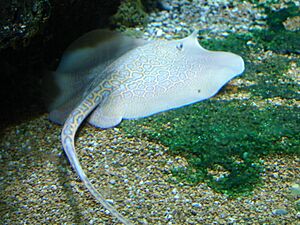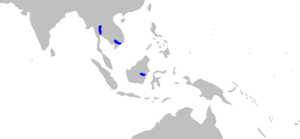Marbled whipray facts for kids
The marbled whipray (Fluvitrygon oxyrhynchus) is a type of stingray that lives in freshwater rivers in Southeast Asia. It has an oval body, a long, pointed nose, and a very long, thin tail. Its back is covered in many small, heart-shaped bumps. It also has a cool pattern of brown spots that look like a net on a light background. This ray can grow up to 36 cm (14 in) wide. Sadly, the marbled whipray is an Endangered species. It is greatly threatened by fishing and losing its home.
Quick facts for kids Marbled whipray |
|
|---|---|
 |
|
| Conservation status | |
| Scientific classification | |
| Genus: |
Fluvitrygon
|
| Species: |
oxyrhynchus
|
 |
|
| Range of the marbled whipray | |
Contents
About the Marbled Whipray
A French zoologist named Henri-Emilé Sauvage first described the marbled whipray in 1878. He called it Trygon oxyrhynchus. He found a female specimen near Saigon, Vietnam. For a long time, people thought it was the same as another stingray, Himantura uarnak. But later, scientists realized it was its own unique species. You might also hear it called the longnose marbled whipray or the marbled freshwater stingray.
Where Marbled Whiprays Live
The marbled whipray is one of the few types of stingrays that lives only in fresh water. It has been found in rivers like the Mekong River in Cambodia, the Nan River and Chao Phraya River in Thailand, and the Mahakam River in Indonesia. The groups of rays in these different rivers probably live separately from each other. This stingray likes to live on the bottom of rivers, especially where there is sand. It can even bury itself in the sand to hide.
What Marbled Whiprays Look Like
The marbled stingray has a thin, oval-shaped body that is longer than it is wide. Its nose is long and shaped like a triangle, sticking out from its body. It has small eyes, and right behind them are two holes called spiracles, which are much bigger than its eyes.
Inside its mouth, there are small bumps called papillae. It has many rows of teeth, like a flat pavement, which help it crush its food. Its tail is very long, about three times the length of its body. It has two long stinging spines on top of its tail. After these spines, the tail becomes very thin, like a whip, with no fins.
Its back is covered in many flat, heart-shaped bumps called dermal denticles. These bumps are thickest in the middle of its back and become smaller towards the edges. There are also bigger, heart-shaped bumps scattered around, especially near its "shoulders." A line of about 40 flat bumps runs down the middle of its back, from between its eyes to its tail spines. Adult rays also have two lines of spiny bumps along the sides of their tail.
The top of the ray is white or light gray, with brown spots that form a net-like pattern. This pattern fades towards the edges of its body. Younger rays have many irregular dark spots. The underside of the ray is completely light-colored. This ray can grow to be about 36 cm (14 in) wide.
Biology and Reproduction
Scientists don't know a lot about the daily life of the marbled whipray. It probably eats small creatures that live on the river bottom, like tiny crustaceans (like crabs) and molluscs (like snails). Like other stingrays, the marbled whipray gives birth to live young. The mother provides special "uterine milk" to feed her babies while they are growing inside her.
Marbled Whiprays and People
Only a few marbled whipray specimens are kept in museums. However, people have reported that they are common in some rivers and streams. These rays are sometimes caught by accident by fishers using nets or hooks. Young marbled whiprays are also popular in the aquarium trade because of their attractive colors.
Another big problem for the marbled whipray is losing its home. This happens because of pollution, logging (cutting down trees), and building dams. For example, dams on the Chao Phraya River in Thailand have stopped stingrays from moving freely, which can hurt their genetic diversity.
Because of these threats, the International Union for Conservation of Nature (IUCN) has listed the marbled whipray as Endangered. In the 1990s, the Thai government tried to start a program to breed these and other endangered freshwater stingrays, but it was put on hold.


